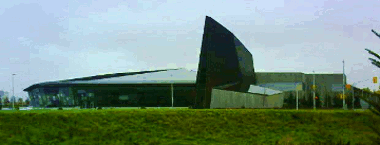What are brownfields?
Brownfields are properties that are vacant or underused. They may be contaminated due to how they were used in the past, but have the potential to be redeveloped. Brownfield sites may have been used for industrial, commercial or institutional purposes, and in some cases these facilities operated before modern environmental regulations and standards existed.

The Canadian War Museum is built on a former brownfield site.
Due to concerns about the safety of soil and groundwater in these areas, brownfield sites need to be tested and where necessary cleaned up, so they can be used to their maximum potential.
Brownfield sites are often located in prime areas of our towns and cities – along a waterfront, at a river’s edge or right downtown. These are excellent locations for new or revitalized uses – for houses, businesses and parks. Usually, these areas are already serviced by roads, water and sewer systems, and hydro. Brownfields may also be found in small urban and rural municipalities, where they may be the sites of former gas stations, landfills and other industrial and commercial activities.
Brownfields are often perceived by the public – whether accurately or not – to be dirty or contaminated. As a result, municipalities and developers have tended not to develop these sites and instead have focused on development of greenfields, building low-density subdivisions and leading to urban sprawl. Greenfields are usually farmland, so suburban development replaces valuable agricultural lands.
It makes sense to redevelop brownfield sites for environmental, social and economic reasons. Cleaning up contaminated lands also provides better quality land and water, and restores lands to a healthier condition. The public can be instrumental as community champions in helping brownfields sites be redeveloped.
When brownfield sites are in desirable locations, their development offers opportunities for smart growth through urban intensification – the redevelopment of existing urban areas at higher population densities. This means that there will be less need to put developments on greenfield lands. It has been estimated that every hectare of land developed in a brownfield project may save up to 4.5 hectares of greenfield land in an outlying area from development.
In spite of all these reasons to redevelop brownfields, it has often been difficult for developers to do so. Brownfield projects frequently involve more uncertainty and complications than greenfield development, because the amount and nature of contamination is generally not known. Cleaning up the site may be costly and time-consuming.
More:
What are the benefits of brownfield redevelopment?
What are the risks to developing brownfields?
What are the barriers to developing brownfields?
What can be done with brownfield sites?
How is brownfield remediation regulated in Ontario?
How can members of the public get involved in local brownfield redevelopments?
How can I learn more about brownfield redevelopment?